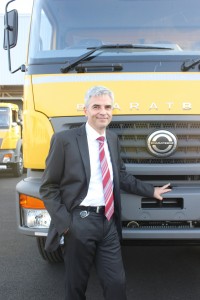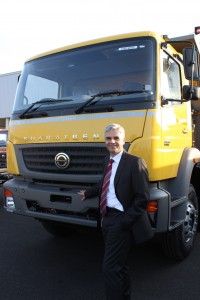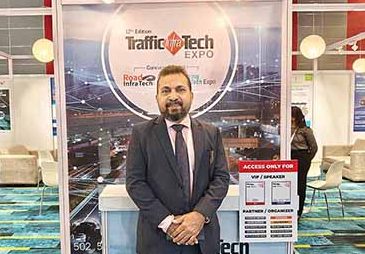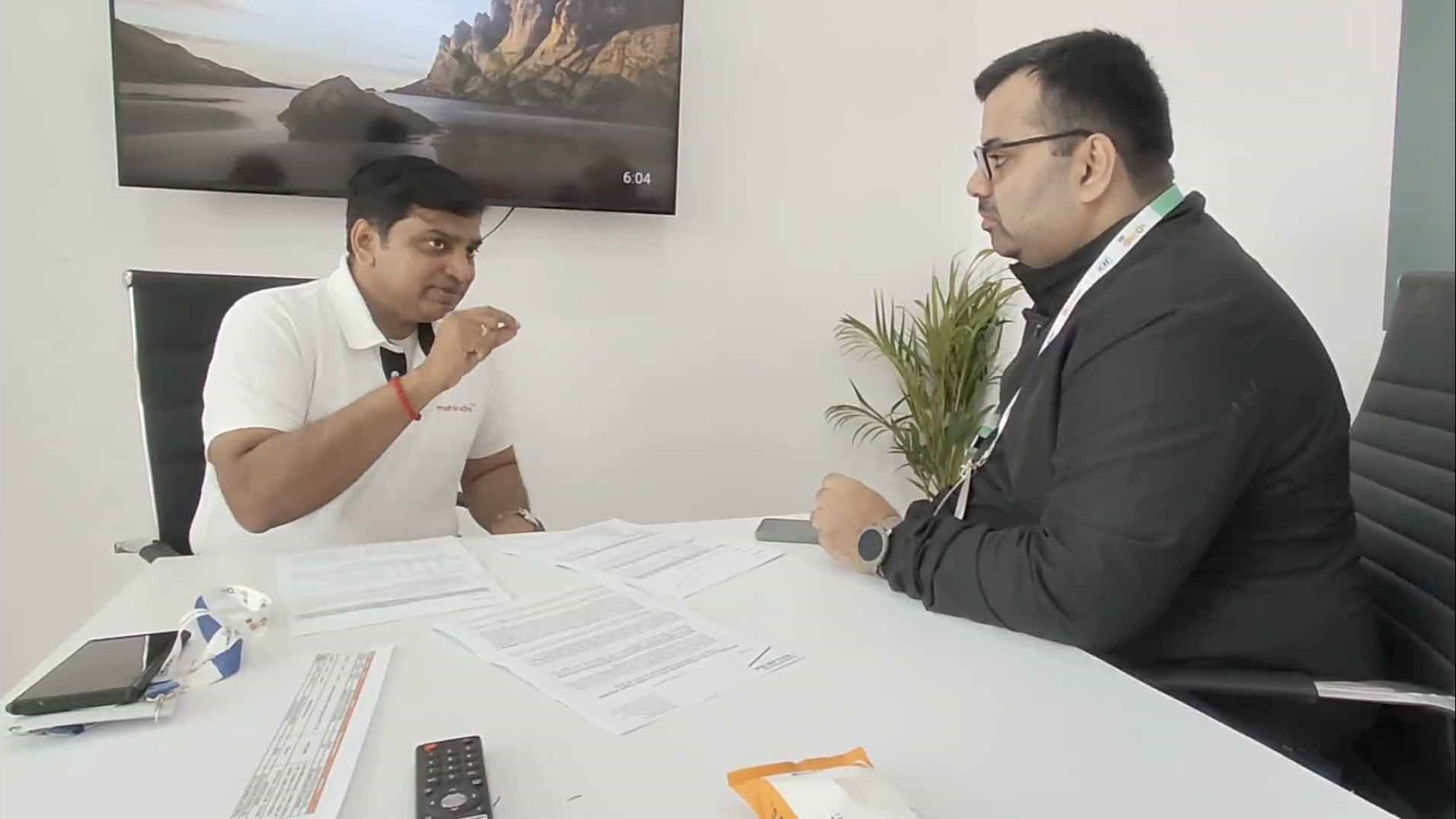Erich Nesselhauf has been involved in the Daimler India Commercial Vehicles’
greenfield project from 2008 and built the entire supplier base for the company,
achieving a localisation of 85% for BharatBenz trucks at the start of production in
2012. Recently he was elevated as the Managing Director & CEO of the company. He
shared his views with T Murrali on the supplier development programme and the road
ahead for them. Edited excerpts from the interview.
 Q: Indian arm – DICV, you had regular suppliers for your range of trucks but still you localised; what was the intent?
Q: Indian arm – DICV, you had regular suppliers for your range of trucks but still you localised; what was the intent?
Nesselhauf: One was cost. We wanted to achieve certain target costs to be competitive, reduce logistic costs to try and give Indian customers the same quality on the international scale. We cannot realise this by importing parts because there are various costs on sea freight, air freight, and packaging as also import duties to be considered, which no customer is willing to pay for. Secondly, the truck will not be perceived as a local truck if we import all the parts. The customers would feel that it is an imported vehicle so there would be difficulty in getting spares. If you import systems from abroad then you will never be perceived as a local manufacturer.
Q: Will the landed price be more considering the investments made by DICV on supplier development; if so what will be the price difference and what is the current localisation level?
Nesselhauf: You should consider a minimum reduction of 20% in cost if you want to localise. You have to set off development costs, management costs, cost of training and refinance but going below this figure makes no sense. We have localised 85% overall, and even more than 90% on some parts.
Q: Were there benchmarks for you to develop vendors in India?
Nesselhauf:Not really. We have developed our own benchmarks, which are now even used in
other Daimler entities around the world, as they have proven successful.
Let me come back to the pricing issue and the total cost. We did not reduce price only on certain parts. We looked into all safety issues and made sure our suppliers were located near the plant to bring down logistic costs. So all issues have to be factored in before you arrive at the total cost, achieving 20% cost reduction. Over 40% of our material value is within 50 km of our plant and this makes a vital difference to costs. So, logistic cost is a prime aspect when you start operations. Also, the required facilities, the available infrastructure and the necessary supply chain – all contribute to the final price of the vehicle; it is not just the reduced price of individual parts. We have to consider the total cost of ownership. For example, if the welding cost is cheaper in Punjab, it makes no sense to go for it as the price will be off-set by the transportation charges. So the
landed cost has to be considered.
In our production we focus mostly on assembly so the challenge is to transport the parts by maintaining the high quality. There has to be special packaging and protection against dust and we have to take care of humidity and transportation damages. I can stock components for months without drop in quality. All these have to be factored in when we talk about costs.
Q: Can you compare and contrast vendors in other places to those in India?
Nesselhauf: In the past we have developed vendors in Europe, parts of Asia, South Korea and China. In comparison the best plus for India is that you had consistent growth in the past; so everybody is willing to invest and set up new plants in the country, because they believe in further growth. The environment is business friendly; the government supports and encourages investment. Labour cost is not even the biggest plus. Compared to all costs in the total, labour cost does not have a big impact. The quality of top management and the supply managers are the most important factors. Our strong point is that we have good equipment and timely availability. However, it is difficult to get special tools produced here in India, most of the special tools we use are imported from Europe, Taiwan and China.
Q: Why is this so?
Nesselhauf:May be this is because of the Indian educational system where you don’t learn to work with your hands and so you don’t have good tool makers. Your education system is more theoretical than practical so in some aspects there is a lack of craftsmanship. Craftmannship is a knowledge that you will not find in books; real information is not from the technical drawing but from the workers or engineers who really know how to produce the part. It is important to know the makeup of parts thoroughly right from the material composition to heat treatment process and machining to exact dimensions. The challenge is how to align the physical parts.
“We believe in thinking
out of the box. If
we want to localise
something we should
make the locals do it,
instead of delegating
the localisation.”
Q: What negatives have you found in the suppliers here? Is there any difference when compared with those in the rest of the world?
Nesselhauf: There is not much of a difference. You have some excellent suppliers here as well as some low class ones. The country is big enough to have all types of suppliers but for us the challenge was to pick the right type. Out of thousands of suppliers we have picked only about 200; and we could upgrade some of these suppliers to achieve a our required standard of quality. Of course suppliers who have no idea about processes and systems would not qualify; we had to look for already highly professional manufacturers and then work with them to achieve our quality requirements.
Q: How did you do it?
Nesselhauf:What we did was to upgrade some suppliers to the next level. We have sent a number of them to Germany and Japan, particularly to learn about special technologies. We also had German workers here to show them how to optimally produce the component.
Q: Were there challenges in developing vendors here?
Nesselhauf:Challenges were basically in cultural issues and language. For example, if someone in India says “we are working hard on it”, it can mean “we will try but its almost not possible” but in Germany the same phrase would mean that they will achieve the target by all means. So sometimes you get annoyed, if you find out something failed only in the end of the process, but the partner feels he has warned you enough times before. You have to develop a common language and understanding over time. What is required here in India is micro tracking; we visit every supplier on a regular basis. Sometimes we know more about the supplier than he knows about his own company. I know exactly when a company needs to invest for the next capacity expansion course and the tools required for it. Practically all the press tools that our suppliers use have been produced in South Korea. We measure all tools in advance at the Tool-supplier, check minimum 150 to 500 parts made by each tool and only if the parts are one hundred percent okay the tool gets packed and shipped to our supplier. We synchronise all these tools – for particular jobs and for particular suppliers. The challenge is to see that hundreds or thousands of tools get ready at the same time at different locations, come together and perform. It’s like directing a big orchestra. It’s not enough to have all instruments in place, if only one instrument plays its tone to olate, the whole symphony will sound bad.
We have done backup planning for all our suppliers in terms of what kind of support they need to organise their production effectively. We have our experts lined up to provide synchronisation of efforts between us and the supplier. At the end, you have to direct the entire value chain from raw material to finished product.
Q: I understand from your suppliers that the information exchange between the management and the workforce is aligned ensuring that quality parts come out from the assembly line. How do you maintain this entire information flow?
Nesselhauf:I call all my suppliers on a regular basis or I visit them. If a supplier has problems in quality or delivery, I arrange monthly review meetings, especially if it’s an ‘in-focus’ supplier. I ask their CEO to meet me, which means that he will have all the relevant information about the problem; he will first meet my team and explain the issue before meeting me. It’s a very, very orchestrated process so when he comes into my room, I have all the applicable details on how we can help him. We are able to talk on the same level. Each supplier has to know which part is safety- critical. He has to understand this, otherwise he cannot perform; there is no other choice.
Q: I understand from your vendors that you have chosen those who did not have tie-ups with foreign companies, unlike other MNCs operating out of India; Why is that so?
Nesselhauf:If we wanted only foreign suppliers, they would have to come and set up manufacturing units in India to supply us here. If we were to depend on only such companies, then we would really have struggled. Second point is that I want to take all the advantages that Indian suppliers have to offer such as the advantages of time, speed and cost. European companies will have to make higher investments that would slow them down and raise the cost for the provided parts. A European company is considered only if some specific technology is required. I prefer to teach somebody whom I trust how to do something, rather than have hundreds of companies from outside willing to supply at higher cost. For example, Koreans prefer to work with Korean companies and with Korean managers everywhere, in which case does this promote innovation? We believe in thinking out of the box. If we want to localise something we should make the locals do it, instead of delegating the localisation.
 Q: You have around 220 suppliers. How many of them passed at the first instance when you assessed them?
Q: You have around 220 suppliers. How many of them passed at the first instance when you assessed them?
Nesselhauf:We measure all suppliers on performance and they have to fulfill our minimum criteria but for a good supplier we invest a lot of working hours and knowledge to upgrade him. Still, some of the suppliers struggle, some of them we replace; every year we consider some new suppliers but there is a firm commitment to stick to the best. If they perform we will never walk away, if they don’t then we think of all other options.
Q: So how many have been dislodged so far?
Nesselhauf: I can’t give you the exact figure but it’s in low single digits. It is below the attrition rate you have in any company. If somebody does not perform we issue one warning and offer support. I never give a second. It’s a great learning for the vendors; they have to understand the quality parameters, if they don’t we will show them the door.
Q: At what average ppm levels do the vendors supply?
Nesselhauf:I will not comment on ppm levels for now. For me, ppm is not the criterion. It is high quality, on time. That’s it. We access each supplier for such a long time that it comes as a surprise if he is suddenly not meeting our standards. For our big suppliers this issue has never been there, only with smaller suppliers who had to upgrade themselves. Nevertheless, if a supplier is not able to or cannot ramp up with us, then I consider all options because we don’t wait for somebody and endanger our entire operations.
Q: Does the hand holding continue?
Nesselhauf:It will continue lifelong. We support all our suppliers, they are our biggest investment. For example, we support suppliers not only in technology transfer but if required we design the assembly line for them. We guide them to optimise production. There are cases where we have completely restructured the assembly line, so efficiency goes up. If he wants to use our techniques to supply to other OEMs we encourage him to go ahead because the more experience he gets the better it is for us. We even offer to train their people in our efficiency programme every year. Like in the vocational education system, I take the workers from them and train him for six months. By doing this I upgrade the supplier’s plant. This is my key – the better a supplier performs, the lesser the issues I have with him. That is why we invest in training, communication, regular meetings, understanding issues, helping them when they really need something and understanding individual problems. We have a task force at hand to attend to glitches, to support him immediately.
Q: How do you manage your suppliers during slowdown?
Nesselhauf: We are currently still a small lead player in this market and we have not faced this so far because once we invest in somebody we have to allow and plan for all situations. A slowdown is an opportunity – we use it to advance some programmes, upgrade products and optimise the production facility. During the slowdown we have modified some things to be in better shape. I expect the suppliers to do the same as they have to sustain themselves. Many Indian companies respond to a crisis by laying-off workers. Then, again, they go through the process of rehiring and have to start training from scratch. I believe in a stable workforce and in continuous training and retraining because you need to have permanent good workers who can take your company to the next level. This is also applicable to most Tier-2 and Tier-3 suppliers especially for critical components.
Q: What are the learnings from the vendor development process which Diamler thinks is very important?
Nesselhauf:Learnings are always built into a time frame. The biggest learning for me is not just to look at the tools and production but at the facility that is set up because that will decide when the plant will be able to service orders. A holistic view of the entire business is very important; I do not believe too much in only functional aspects. We need people with a bird’s eye view and understanding.
Q: Some of your suppliers have started exporting components. Is there a possibility for Indian suppliers to be single source for a particular component for Diamler globally?
Nesselhauf: We already have. For example, Bharat Forge exports a lot of I-beams used in trucks for defence. They supply large volumes to Daimler in India, Europe and USA but in Japan we have a different supplier. Though not strictly a single source, the volumes supplied are huge. The annual purchase volume for Daimler trucks is 12 to 15 billion Euros so for a single source it would be really colossal. Indian manufacturers may not be able to cater to that capacity.
We plan to set up a full-fledged consolidation centre where we will source the parts in India, pack and ship it to different destinations. This is the kind of service we do for our suppliers. It’s a different story for the individual suppliers where it would be difficult to forward those parts globally. The exports include machine parts, castings and forgings. The centre is still in the build-up phase but we have already shipped the first consignments. We forward about 3000 different types of parts. We are one of the few OEMs in India who can offer such an elaborate export facility.
“What is required
here in India is micro
tracking; we visit every
supplier on a regular
basis. Sometimes we
know more about
the supplier than he
knows about his own
company.”
Q: You have made the vendors shift from ‘manufacturing to print’ to ‘joint development and manufacturing.’ So what’s next for them?
Nesselhauf: Develop parts, start innovation. In the past it was good enough here to produce built-to-print. In the last 20 years in commercial vehicles, unfortunately, not too many new developments have happened in India. Even some of the trucks for a homegrown company is developed in Korea.
We have to develop parts in India – for India and the world. Why do we have so many engineers here? To produce the same parts at the end of the day or to upgrade them? The knowhow is here. We have to take it to the next level and develop the capability to produce improved components; of course, it has to follow the regulations of the market.
Q: So you want them to provide solutions.
Nesselhauf:Sure; this is our strong belief that we don’t end up providing all solutions. I expect them to do it. You have Indian suppliers that have global operations like Motherson, the largest mirror manufacturer who has the competency to upgrade to higher levels; they have to invest in R&D – I mean real research and development – which will increase the number of patents here. Maybe they could come up with new technologies and new parts.
Look at Nokia – it used to be No. 1 but has declined over the last decade. Why? Because they had not enough innovation anymore. It was one of the best innovative companies earlier but suddenly became saturated and stopped inventing. If you stop innovation everybody can overtake you. That’s why I said that without innovation India is replaceable. I can produce trucks everywhere; if I have nothing here which makes this country unique besides the large population – why would I be here?
Why is someone here investing in call centres? Is there anything unique in having a call centre in India? You have to add value. Business minus cost is value. If you add value, you are irreplaceable. For me, R&D needs to be here, but real research – and real development, not just on the surface level. The capability is here but it’s not entertained; you are also not challenged to do it. ACI








Homepage
… [Trackback]
[…] Read More Infos here: autocomponentsindia.com/the-best-plus-for-india-is-consistent-growth-erich-nesselhauf/ […]